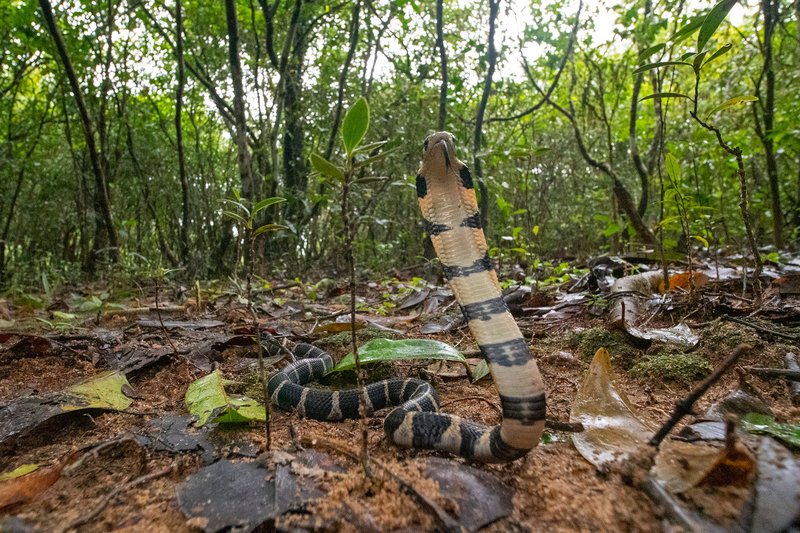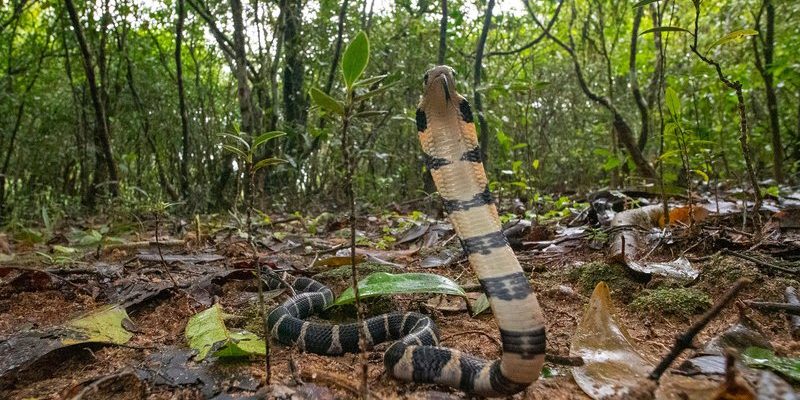
Now, most people think they know what a cobra is, but the king cobra is in a league of its own. It’s not just the longest venomous snake in the world; it has some pretty surprising behaviors and adaptations that set it apart. So, whether you’re a snake lover or simply curious about wildlife, let’s dive into ten intriguing facts about the king cobra that you probably didn’t know!
1. It’s Not Just a Cobra
Here’s the thing: while all cobras are venomous, the king cobra (Ophiophagus hannah) is unique. It doesn’t belong to the typical cobra family. Instead, it’s part of the Elapidae family, which includes other venomous snakes like mambas and coral snakes. While other cobras eat mostly rodents and birds, the king cobra has a special culinary preference for other snakes, even other cobras. Imagine being a snake and having to look over your shoulder for dinner!
This diet is quite rare among snakes. They have special digestive enzymes that allow them to break down the proteins in their slippery meals. So, while most snakes might shy away from fellow reptiles, the king cobra is fearless.
2. They Can Grow Over 18 Feet Long
When it comes to size, the king cobra isn’t just large; it’s massive. Adult king cobras can reach lengths of up to 18 feet—now that’s longer than most cars! The average size ranges from 10 to 13 feet, which still feels monumental. Just think about that next time you’re measuring a room or a piece of furniture.
Their sheer length makes them a formidable presence in the wild. It’s not just their size that keeps them safe; it’s also how they carry themselves. They can lift up to a third of their body off the ground, which displays their impressive hood in a stunning and intimidating show. This behavior is often enough to scare off would-be threats without needing to strike.
3. The King Cobra’s Venom is Potent
Now, if we’re talking about the king cobra, we must mention its venom. Honestly, the venom of a king cobra is among the most potent of all snake species. Just a single bite can deliver enough neurotoxin to kill an elephant. Yikes!
But here’s the interesting part: while the venom is incredibly strong, king cobras are usually not aggressive unless provoked. They prefer to avoid confrontations, using their impressive size and appearance as their first line of defense. If cornered, however, they can deliver a deadly bite that can incapacitate their prey almost instantly.
4. They Have a Strong Maternal Instinct
You might think that reptiles are cold-blooded in more ways than one, but that’s not the case for the king cobra. Female king cobras showcase a strong maternal instinct that’s pretty rare among reptiles. After mating, a female lays around 20 to 40 eggs and then wraps her body around them to keep them warm.
She doesn’t leave them unattended either. The mother stays nearby, protecting her eggs from potential threats until they hatch. This nurturing behavior is quite remarkable in the animal kingdom and shows that even tough creatures like the king cobra can have a soft side.
5. They Make Unique Sounds
Ever heard a snake make a sound? It’s pretty uncommon, right? Well, king cobras can actually make a noise that sounds like a “hiss.” It’s not just any hiss; it’s a loud, distinct sound produced by forcing air through their throat. They do this when they feel threatened or are trying to warn off intruders.
Imagine if a snake could shout at you! This unique vocalization adds a whole new layer to their personality. So, if you ever find yourself in the presence of a king cobra and hear it hiss, it might be time to step back slowly.
6. They’re Found in Diverse Habitats
King cobras don’t limit themselves to just one type of habitat. They can be found across various environments in Southeast Asia, ranging from forests to mangroves, and even in agricultural fields. This adaptability is one of the reasons they’re such successful predators.
They prefer areas close to water bodies, like rivers and streams, but also thrive in dense jungles. This versatility in habitat demonstrates their ability to find food and shelter, even in changing environments. It’s like they’ve mastered the art of living in harmony with their surroundings.
7. They Can Live for Over 20 Years
In captivity, king cobras can live to be over 20 years old, which is quite impressive for a snake. In the wild, their lifespan tends to be shorter due to predators and environmental challenges. Imagine having a pet snake that could live as long as some dogs!
In captivity, they thrive when provided with the right diet and care, and their longevity offers researchers valuable insights into snake behavior and physiology. This extended lifespan allows these majestic creatures to continue captivating us for years to come.
8. They Have Great Vision
Unlike many snakes, king cobras have excellent eyesight. They can see quite clearly, which helps them spot potential prey from a distance. Their vision is so good that they can even detect movement in dim light.
This keen eyesight, combined with their remarkable sense of smell, makes them incredibly effective hunters. Imagine walking through the forest, and you have both wired senses at your disposal—it’s a natural way of life that gives them a significant edge over their prey and potential threats.
9. They’re Not the Only Large Snakes
While king cobras are certainly impressive, they share their habitats with other notable snakes, like reticulated pythons and green anacondas. However, unlike these constrictors, which rely on wrapping around and suffocating their prey, king cobras depend on their venom.
This difference in hunting style is fascinating. It showcases the versatility of snakes. In some ways, the king cobra acts like a ruthless predator, while the pythons and anacondas take a more stealthy approach.
10. They Play a Role in Ecosystem Balance
Lastly, king cobras are more than just fierce predators—they play an essential role in their ecosystems. By keeping populations of other snakes in check, they help maintain balance within their habitats. Too many rodents or other small creatures can lead to an imbalance, affecting the entire ecosystem.
Here’s the thing: every creature, big and small, has a role to play in nature. By controlling the populations of snakes, king cobras help ensure a healthier environment for all wildlife. So the next time you think about snakes, remember that they’re not just scary creatures; they’re vital parts of their ecosystems.
In conclusion, the king cobra is not only an awe-inspiring creature; it’s also a complex part of the natural world. From its impressive size and diet to its unique behaviors, there’s so much more to learn about these magnificent snakes. So, the next time you hear about the king cobra, I hope you recall some of these fascinating facts that highlight its importance in our ecosystem and its unique place in the animal kingdom.

